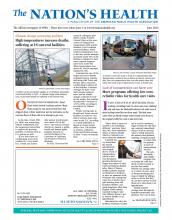
Photo by AzmanL, courtesy iStockphoto
It’s invisible, tasteless and odorless. It’s the second leading cause of lung cancer. If you haven’t guessed yet, we’re talking about radon.
Radon is a naturally occurring radioactive gas that can enter your home through the ground. It can build up to dangerous levels in the air you breathe. When inhaled, the radioactive particles can cause lung cancer.
Radon comes from the natural decay, or breakdown, of uranium in soil, rock and water. It can be found throughout the U.S. in any type of building, including homes, schools and offices.
But in most cases, your greatest chance of being exposed to dangerous levels of radon is in the place you spend most of your time: at home.
The U.S. Environmental Protection Agency estimates that 1 in 15 homes across the country tests positive for dangerous levels of radon. In addition to lung cancer, radon is associated with higher risks of cardiovascular disease, especially from heart attack or stroke, and is linked to 20,000 deaths a year.
“Radon is a silent killer that often gets people where they feel safest, which is their homes,” says Paul Locke, DrPH, JD, MPH, a professor in the Department of Environmental Health and Engineering at Johns Hopkins Bloomberg School of Public Health. “The health risk associated with radon depends on the level of radon you’re exposed to and gets in your lungs. But really, no level of radon is safe.”
Whether your home is new, old, drafty or sealed tight as a drum, any home can have a problem with radon. In most cases, this unwelcome radioactive guest sneaks in by moving through the ground to the air, where it makes its way through your home’s joints in walls, small cracks, holes in the foundation and other openings. Once inside, the gas becomes trapped and can build up to dangerous levels.
Don’t wait to investigate
Any radon exposure carries some risk, and no level of radon is safe, says Tommy Bowles, who leads EPA’s national radon team.
“Unless you test for it, there’s no real way of telling how much is present,” Bowles says.
When it comes to radon, a common misconception is that it’s not necessary to test if a neighbor’s home tested low. Radon levels vary based on what’s underneath your house. In other words, even if your neighbor’s house is right up against yours, your levels can be very different.
“If you’ve got a formation of rock under your house that produces a lot of radon, your house is going to have a lot of radon, but the house next to you could have absolutely none at all,” Locke says. “The only way to know is to test.”
Radon test kits are typically charcoal canisters and can be purchased online or in hardware stores for as little as $20.
Short-term tests, which measure radon over two to four days, can provide a good snapshot of your radon levels, Bowles says.
However, as radon fluctuates depending on weather, barometric pressure and the season, long-term tests of 90 days or more are a better indicator of your home’s year-round average level of radon, Bowles says.
No matter the kind of test, you’ll need to follow the directions on the packaging for the proper placement of the device and where to send the device after you test to find out your radon level.
According to the Centers for Disease Control and Prevention, people who receive their water from a well should also test it for radon, as well water can carry radon gas into your home.
If you don’t feel comfortable doing the testing yourself, you can also hire a professional to come to your home.
If you’ve tested and the results indicate a radon problem, don’t wait. EPA recommends that you reach out to a qualified radon service provider. They can fix the problem by installing a radon mitigation system.
The most common kind of system collects radon gas from underneath the home’s foundation and uses a fan to vent it through a PVC pipe, sending it above and away from your home.
“The more you can lower that level, the better,” Bowles says.
- Copyright The Nation’s Health, American Public Health Association









